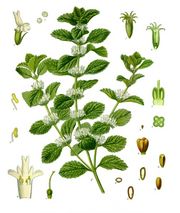Marrubium vulgare: Difference between revisions
No edit summary |
No edit summary |
||
| (One intermediate revision by one other user not shown) | |||
| Line 1: | Line 1: | ||
{{ | {{SPlantbox | ||
| | |familia=Lamiaceae | ||
| | |genus=Marrubium | ||
| | |species=vulgare | ||
|Min ht metric=cm | |||
| | |Temp Metric=°F | ||
| | |jumpin=This is the plant information box - for information on light; water; zones; height; etc. If it is mostly empty you can help grow this page by clicking on the edit tab and filling in the blanks! | ||
| | |image=Koeh-224.jpg | ||
| | |image_width=180 | ||
| | |image_caption=Marrubium vulgare | ||
| | |||
}} | }} | ||
'''''Marrubium vulgare''''' ('''White Horehound''' or '''Common Horehound''') is a [[flowering plant]] in the family [[Lamiaceae]], native to [[Europe]], northern [[Africa]] and [[Asia]]. | '''''Marrubium vulgare''''' ('''White Horehound''' or '''Common Horehound''') is a [[flowering plant]] in the family [[Lamiaceae]], native to [[Europe]], northern [[Africa]] and [[Asia]]. | ||
| Line 19: | Line 14: | ||
It is a greyish-leaved [[herbaceous]] [[perennial plant]], somewhat resembling [[Mentha|mint]] in appearance, which grows to 25-45 cm tall. The [[leaf|leaves]] are 2-5 cm long with a densely crinkled surface, and downy-hairy. The [[flower]]s are white, borne in clusters on the upper part of the main stem. Like other members of [[Lamiaceae]], horehound has a square stem. | It is a greyish-leaved [[herbaceous]] [[perennial plant]], somewhat resembling [[Mentha|mint]] in appearance, which grows to 25-45 cm tall. The [[leaf|leaves]] are 2-5 cm long with a densely crinkled surface, and downy-hairy. The [[flower]]s are white, borne in clusters on the upper part of the main stem. Like other members of [[Lamiaceae]], horehound has a square stem. | ||
'''Marrubium vulgare''' is also used as a natural [[grasshopper]] repellant in agriculture. | |||
{{Inc| | |||
Marrubium vulgare, Linn. Common Horehound. Height 1-3 ft.: sts. ascending, woolly or tomentose: lvs. ovate to round-ovate, stalked: calyx with 10 recurved teeth, the alternate ones shorter: fls. whitish. Summer.— Now found as an escape from gardens in waste places of nearly every country of the world. Horehound is used in large quantities for confections and medicines for coughs and colds. | |||
}} | |||
==Cultivation== | |||
===Propagation=== | |||
===Pests and diseases=== | |||
==Varieties== | |||
==Gallery== | |||
<gallery perrow=5> | |||
<gallery> | Image:Upload.png| photo 1 | ||
Image:Upload.png| photo 2 | |||
Image:Marrubium_vulgare0.jpg|flowers | Image:Marrubium_vulgare0.jpg|flowers | ||
Image:Marrubium vulgare.jpg|foliage of young plants | Image:Marrubium vulgare.jpg|foliage of young plants | ||
Image:Horehound bug.jpg|Horehound bug, a common [[insect]] that feeds on White Horehound | Image:Horehound bug.jpg|Horehound bug, a common [[insect]] that feeds on White Horehound | ||
</gallery> | </gallery> | ||
==References== | |||
<references/> | |||
*[[Standard Cyclopedia of Horticulture]], by L. H. Bailey, MacMillan Co., 1963 | |||
<!--- xxxxx *Flora: The Gardener's Bible, by Sean Hogan. Global Book Publishing, 2003. ISBN 0881925381 --> | |||
<!--- xxxxx *American Horticultural Society: A-Z Encyclopedia of Garden Plants, by Christopher Brickell, Judith D. Zuk. 1996. ISBN 0789419432 --> | |||
<!--- xxxxx *Sunset National Garden Book. Sunset Books, Inc., 1997. ISBN 0376038608 --> | |||
==External links== | ==External links== | ||
{{ | *{{wplink}} | ||
{{stub}} | |||
__NOTOC__ | |||
Latest revision as of 06:47, 5 January 2010
| Marrubium vulgare subsp. var. | ||||||||||||||||||||||||||||||||||||||||||||||||||||||||
|---|---|---|---|---|---|---|---|---|---|---|---|---|---|---|---|---|---|---|---|---|---|---|---|---|---|---|---|---|---|---|---|---|---|---|---|---|---|---|---|---|---|---|---|---|---|---|---|---|---|---|---|---|---|---|---|---|

|
|
| ||||||||||||||||||||||||||||||||||||||||||||||||||||||
| ||||||||||||||||||||||||||||||||||||||||||||||||||||||||
Marrubium vulgare (White Horehound or Common Horehound) is a flowering plant in the family Lamiaceae, native to Europe, northern Africa and Asia.
It is a greyish-leaved herbaceous perennial plant, somewhat resembling mint in appearance, which grows to 25-45 cm tall. The leaves are 2-5 cm long with a densely crinkled surface, and downy-hairy. The flowers are white, borne in clusters on the upper part of the main stem. Like other members of Lamiaceae, horehound has a square stem.
Marrubium vulgare is also used as a natural grasshopper repellant in agriculture.
| Standard Cyclopedia of Horticulture |
|---|
|
Marrubium vulgare, Linn. Common Horehound. Height 1-3 ft.: sts. ascending, woolly or tomentose: lvs. ovate to round-ovate, stalked: calyx with 10 recurved teeth, the alternate ones shorter: fls. whitish. Summer.— Now found as an escape from gardens in waste places of nearly every country of the world. Horehound is used in large quantities for confections and medicines for coughs and colds.
|
Cultivation
Propagation
Pests and diseases
Varieties
Gallery
-
photo 1
-
photo 2
-
flowers
-
foliage of young plants
-
Horehound bug, a common insect that feeds on White Horehound
References
- Standard Cyclopedia of Horticulture, by L. H. Bailey, MacMillan Co., 1963
External links
- w:Marrubium vulgare. Some of the material on this page may be from Wikipedia, under the Creative Commons license.
- Marrubium vulgare QR Code (Size 50, 100, 200, 500)



